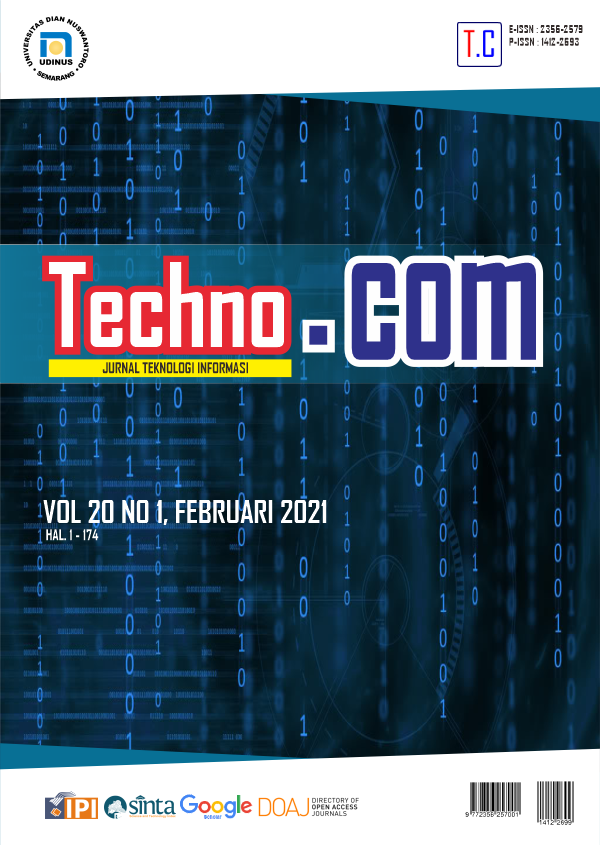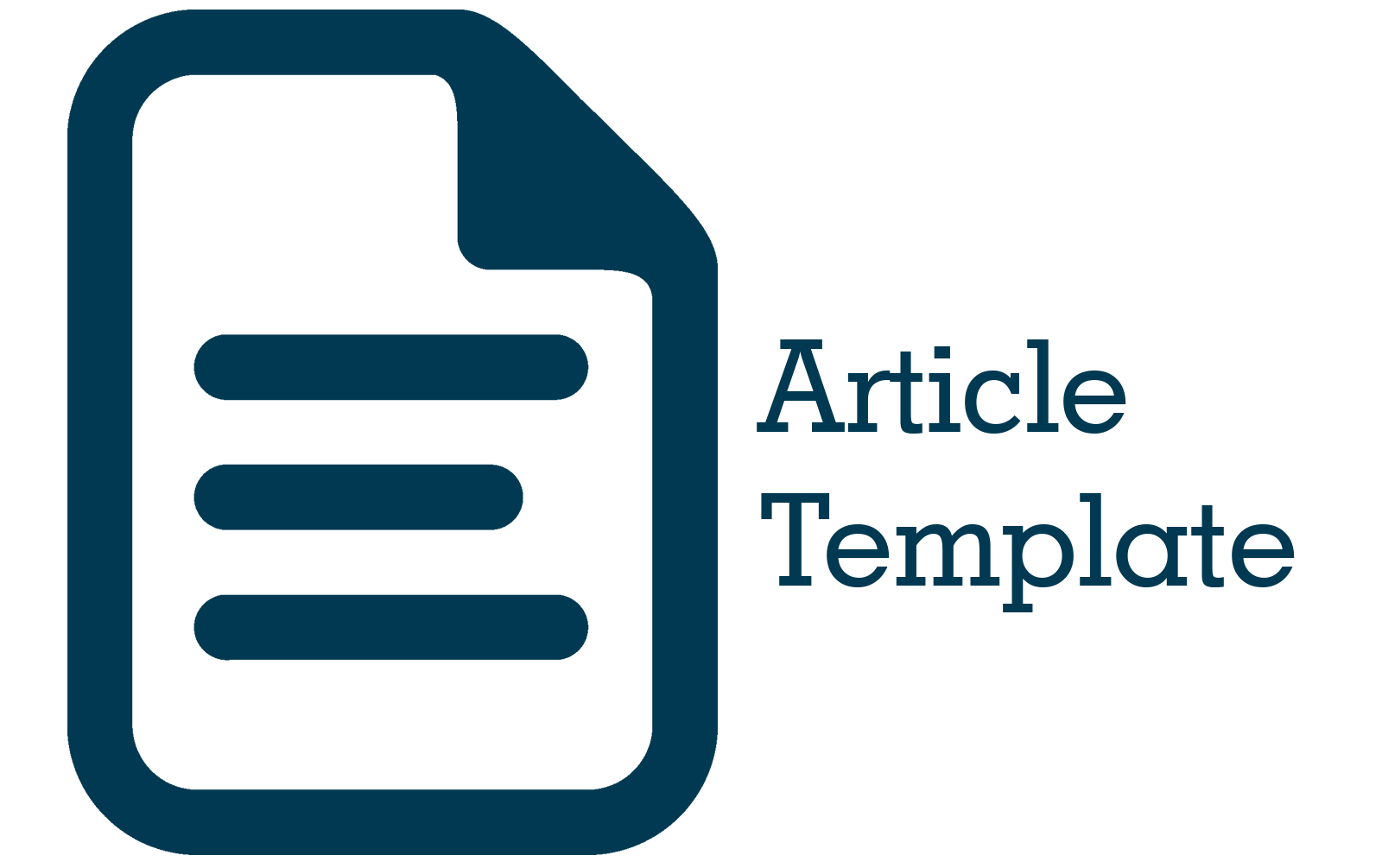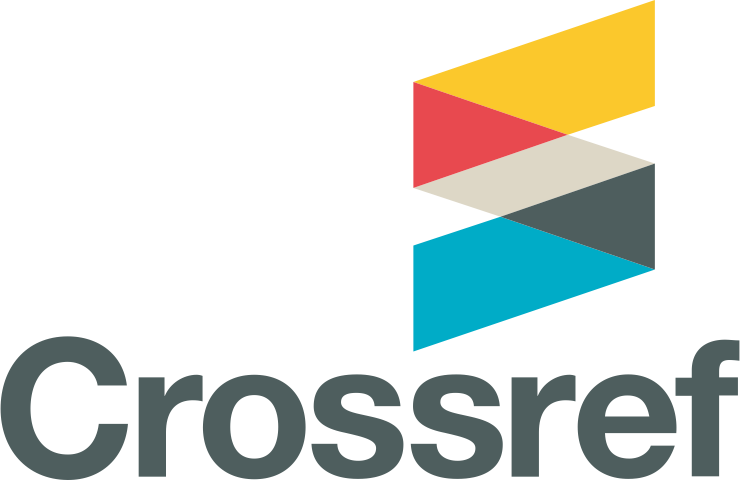Frostid: Aplikasi Pelaporan Jalan Banjir Berbasis Warga Pada Navigasi Berlalu Lintas
DOI:
https://doi.org/10.33633/tc.v20i1.4082Keywords:
sistem pelaporan, jalan, banjir, crowdsourcing, wargaAbstract
Di Indonesia, banjir merupakan masalah utama yang dialami saat musim penghujan setiap tahunnya. Jalan banjir membawa dampak kerugian kepada pengendara kendaraan bermotor misalnya dapat menyebabkan kerusakan mesin, serta penyebab utama terjadinya karat pada kendaraan bermotor. Oleh karena itu, diperlukan upaya peringatan dini, berupa sistem pelaporan banjir, yang memberikan informasi kepada pengendara sehingga mereka dapat mengantisipasi jalan banjir. Pada penelitian ini diusulkan aplikasi pelaporan jalan banjir secara online yang berfokus pada peta navigasi berlalu-lintas untuk pengguna jalan. Aplikasi ini melibatkan partisipasi warga secara aktif (crowdsourcing) yaitu pengumpulan dan penyebaran informasi banjir dilakukan oleh kerumunan (crowd) warga dan dinamakan dengan Flooded Road Reporting System Indonesia (Frostid). Aplikasi mobile Frostid dikembangkan dalam lingkungan sistem operasi Android. Pendekatan pengembangan agile Mobile-D diterapkan. Penerimaan pengguna terhadap aplikasi dievaluasi menggunakan model TAM (Technology Acceptance Model). Metriks yang dievaluasi meliputi kegunaan yang dirasakan, kemudahan pengunaan yang dirasakan, sikap pengguna terhadap aplikasi, dan niat untuk menggunakan. Berdasarkan hasil analisis statistik deskriptif hasil pengujian penerimaan pengguna, dapat disimpulkan bahwa konsep crowdsourcing dalam aplikasi pelaporan jalan banjir diterima oleh pengguna. Kesediaan pengguna untuk merekomendasikan kepada orang lain, juga selaras dengan konsep crowdsourcing, dimana nilai dari aplikasi akan optimal jika banyak pengguna yang berkontribusi.References
M. Pregnolato, A. Ford, S. M. Wilkinson, and R. J. Dawson, “The impact of flooding on road transport: A depth-disruption function,” Transp. Res. Part Transp. Environ., vol. 55, pp. 67–81, Aug. 2017, doi: 10.1016/j.trd.2017.06.020.
L. See, “A Review of Citizen Science and Crowdsourcing in Applications of Pluvial Flooding,” Front. Earth Sci., vol. 7, 2019, doi: 10.3389/feart.2019.00044.
L. C. Degrossi, J. P. de Albuquerque, M. C. Fava, and E. M. Mendiondo, “Flood Citizen Observatory: a crowdsourcing-based approach for flood risk management in Brazil,” in SEKE, Jul. 2014, pp. 570–575.
J. Cools, D. Innocenti, and S. O’Brien, “Lessons from flood early warning systems,” Environ. Sci. Policy, vol. 58, pp. 117–122, Apr. 2016, doi: 10.1016/j.envsci.2016.01.006.
R. Bonney et al., “Citizen Science: A Developing Tool for Expanding Science Knowledge and Scientific Literacy,” BioScience, vol. 59, no. 11, pp. 977–984, Dec. 2009, doi: 10.1525/bio.2009.59.11.9.
“Crowdsourcing Methods for Data Collection in Geophysics: State of the Art, Issues, and Future Directions - Zheng - 2018 - Reviews of Geophysics - Wiley Online Library.” https://agupubs.onlinelibrary.wiley.com/doi/full/10.1029/2018RG000616 (accessed Mar. 23, 2020).
Q. T. Minh, T. N. Chi, and M. Toulouse, “Toward a Crowdsourcing-Based Urban Flood Mitigation Platform,” in Proceedings of the Eighth International Symposium on Information and Communication Technology, New York, NY, USA, Dec. 2017, pp. 301–308, doi: 10.1145/3155133.3155153.
M. Lease and E. Yilmaz, “Crowdsourcing for information retrieval,” ACM SIGIR Forum, vol. 45, no. 2, pp. 66–75, Jan. 2012, doi: 10.1145/2093346.2093356.
L. See et al., “Crowdsourcing, Citizen Science or Volunteered Geographic Information? The Current State of Crowdsourced Geographic Information,” ISPRS Int. J. Geo-Inf., vol. 5, no. 5, Art. no. 5, May 2016, doi: 10.3390/ijgi5050055.
H. N. Do, M.-T. Vo, V.-S. Tran, P. V. Tan, and C. V. Trinh, “An early flood detection system using mobile networks,” in 2015 International Conference on Advanced Technologies for Communications (ATC), Oct. 2015, pp. 599–603, doi: 10.1109/ATC.2015.7388400.
S. B. Serpico, S. Dellepiane, G. Boni, G. Moser, E. Angiati, and R. Rudari, “Information Extraction From Remote Sensing Images for Flood Monitoring and Damage Evaluation,” Proc. IEEE, vol. 100, no. 10, pp. 2946–2970, Oct. 2012, doi: 10.1109/JPROC.2012.2198030.
D. Eilander, P. Trambauer, J. Wagemaker, and A. van Loenen, “Harvesting Social Media for Generation of Near Real-time Flood Maps,” Procedia Eng., vol. 154, pp. 176–183, 2016, doi: 10.1016/j.proeng.2016.07.441.
“Ushahidi or ‘testimony’: Web 2.0 tools for crowdsourcing crisis information (PLA 59),” Jun. 2009, Accessed: Sep. 01, 2020. [Online]. Available: https://pubs.iied.org/G02842/.
S. Koswatte, K. McDougall, and X. Liu, “VGI and crowdsourced data credibility analysis using spam email detection techniques,” Int. J. Digit. Earth, vol. 11, no. 5, pp. 520–532, May 2018, doi: 10.1080/17538947.2017.1341558.
J. Pánek, L. Marek, V. Pászto, and J. Val?ch, “The Crisis Map of the Czech Republic: the nationwide deployment of an Ushahidi application for disasters,” Disasters, vol. 41, no. 4, pp. 649–671, 2017, doi: 10.1111/disa.12221.
T. Ludwig, T. Siebigteroth, and V. Pipek, “CrowdMonitor: Monitoring Physical and Digital Activities of Citizens During Emergencies,” in Social Informatics, Cham, 2015, pp. 421–428, doi: 10.1007/978-3-319-15168-7_51.
M. Middelhoff et al., “Crowdsourcing and crowdtasking in crisis management: Lessons learned from a field experiment simulating a flooding in the city of the Hague,” in 2016 3rd International Conference on Information and Communication Technologies for Disaster Management (ICT-DM), Dec. 2016, pp. 1–8, doi: 10.1109/ICT-DM.2016.7857212.
M. D. Hendricks et al., “The development of a participatory assessment technique for infrastructure: Neighborhood-level monitoring towards sustainable infrastructure systems,” Sustain. Cities Soc., vol. 38, pp. 265–274, Apr. 2018, doi: 10.1016/j.scs.2017.12.039.
P. Abrahamsson et al., “Mobile-D: an agile approach for mobile application development,” in Companion to the 19th annual ACM SIGPLAN conference on Object-oriented programming systems, languages, and applications, New York, NY, USA, Oct. 2004, pp. 174–175, doi: 10.1145/1028664.1028736.
A. Gordillo-Ramírez, O. Alonso-Cuevas, D. Ortega-Pacheco, and U. Vélez-Saldaña, “Mobile Application for the Support in the Learning of the Alphabet, Verbs and Pronouns of the Mexican Sign Language Based on Augmented Reality,” in Telematics and Computing, Cham, 2019, pp. 183–191, doi: 10.1007/978-3-030-33229-7_16.
A. Balaguera and Y. Daniel, “Metodologías ágiles y desarrollo de aplicaciones móviles,” Univ. Inca Garcilaso Vega, Oct. 2013, Accessed: Dec. 15, 2020. [Online]. Available: http://repositorio.uigv.edu.pe/handle/20.500.11818/832.
Y. Lu, T. Zhou, and B. Wang, “Exploring Chinese users’ acceptance of instant messaging using the theory of planned behavior, the technology acceptance model, and the flow theory,” Comput. Hum. Behav., vol. 25, no. 1, pp. 29–39, Jan. 2009, doi: 10.1016/j.chb.2008.06.002.
“Mapbox.” https://www.mapbox.com/ (accessed Mar. 23, 2020).
Downloads
Published
Issue
Section
License
Copyright (c) 2021 Eka Prakarsa Mandyartha, Asif Faroqi

This work is licensed under a Creative Commons Attribution-NonCommercial 4.0 International License.
License Terms
All articles published in Techno.COM Journal are licensed under the Creative Commons Attribution-NonCommercial 4.0 International (CC BY-NC 4.0). This means:
1. Attribution
Readers and users are free to:
-
Share – Copy and redistribute the material in any medium or format.
-
Adapt – Remix, transform, and build upon the material.
As long as proper credit is given to the original work by citing the author(s) and the journal.
2. Non-Commercial Use
-
The material cannot be used for commercial purposes.
-
Commercial use includes selling the content, using it in commercial advertising, or integrating it into products/services for profit.
3. Rights of Authors
-
Authors retain copyright and grant Techno.COM Journal the right to publish the article.
-
Authors can distribute their work (e.g., in institutional repositories or personal websites) with proper acknowledgment of the journal.
4. No Additional Restrictions
-
The journal cannot apply legal terms or technological measures that restrict others from using the material in ways allowed by the license.
5. Disclaimer
-
The journal is not responsible for how the published content is used by third parties.
-
The opinions expressed in the articles are solely those of the authors.
For more details, visit the Creative Commons License Page:
? https://creativecommons.org/licenses/by-nc/4.0/












